Performance of Dual-Energy Contrast-enhanced Digital Mammography for Screening Women at Increased Risk of Breast Cancer
- PMID: 31453765
- PMCID: PMC6776233
- DOI: 10.1148/radiol.2019182660
Performance of Dual-Energy Contrast-enhanced Digital Mammography for Screening Women at Increased Risk of Breast Cancer
Abstract
BackgroundContrast agent-enhanced digital mammography (CEDM) has been shown to be more sensitive and specific than two-dimensional full-field digital mammography in the diagnostic setting. Few studies have reported on its performance in the screening setting.PurposeTo evaluate the performance of CEDM for breast cancer screening.Materials and MethodsThis retrospective study included women who underwent dual-energy CEDM for breast cancer screening from December 2012 through April 2016. Medical records were reviewed for age, risk factors, short-interval follow-up and biopsies recommended, and cancers detected. Sensitivity, specificity, positive predictive value of abnormal findings at screening (PPV1), positive predictive value of biopsy performed (PPV3), and negative predictive value were determined.ResultsIn the study period 904 baseline CEDMs were performed. Mean age was 51.8 years ± 9.4 (standard deviation). Of 904 patients, 700 (77.4%) had dense breasts, 247 (27.3%) had a family history of breast cancer in a first-degree relative age 50 years or younger, and 363 (40.2%) a personal history of breast cancer. The final Breast Imaging Reporting and Data System score was 1 or 2 in 832 of 904 (92.0%) patients, score of 3 in 25 of 904 (2.8%) patients, and score of 4 or 5 in 47 of 904 (5.2%) patients. By using CEDM, 15 cancers were diagnosed in 14 of 904 women (cancer detection rate, 15.5 of 1000). PPV3 was 29.4% (15 of 51). At least 1-year follow up was available in 858 women. There were two interval cancers. Sensitivity was 50.0% (eight of 16; 95% confidence interval [CI]: 24.7%, 75.3%) on the low-energy images compared with 87.5% (14 of 16; 95% CI: 61.7%, 98.4%) for the entire study (low-energy and iodine images; P = .03). Specificity was 93.7% (789 of 842; 95% CI: 91.8%, 95.2%); PPV1 was 20.9% (14 of 67; 95% CI: 11.9%, 32.6%), and negative predictive value was 99.7% (789 of 791; 95% CI: 99.09%, 99.97%).ConclusionContrast-enhanced digital mammography is a promising technique for screening women with higher-than-average risk for breast cancer.© RSNA, 2019.
Figures


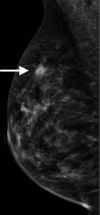
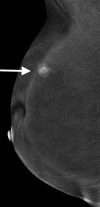

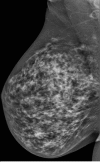


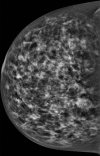

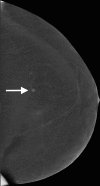
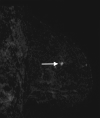
Comment in
-
Dual-energy contrast-enhanced spectral mammography (CESM) for breast cancer screening.Quant Imaging Med Surg. 2019 Nov;9(11):1914-1917. doi: 10.21037/qims.2019.10.13. Quant Imaging Med Surg. 2019. PMID: 31867243 Free PMC article. No abstract available.
-
The emerging role of contrast-enhanced mammography.Quant Imaging Med Surg. 2019 Dec;9(12):2012-2018. doi: 10.21037/qims.2019.11.09. Quant Imaging Med Surg. 2019. PMID: 31929976 Free PMC article. No abstract available.
References
-
- Smith RA, Duffy SW, Gabe R, Tabar L, Yen AM, Chen TH. The randomized trials of breast cancer screening: what have we learned? Radiol Clin North Am 2004;42(5):793–806, v. - PubMed
-
- Tabár L, Vitak B, Chen TH, et al. . Swedish two-county trial: impact of mammographic screening on breast cancer mortality during 3 decades. Radiology 2011;260(3):658–663. - PubMed
-
- Humphrey LL, Helfand M, Chan BK, Woolf SH. Breast cancer screening: a summary of the evidence for the U.S. Preventive Services Task Force. Ann Intern Med 2002;137(5 Part 1):347–360. - PubMed
-
- Tilanus-Linthorst M, Verhoog L, Obdeijn IM, et al. . A BRCA1/2 mutation, high breast density and prominent pushing margins of a tumor independently contribute to a frequent false-negative mammography. Int J Cancer 2002;102(1):91–95. [Published correction appears in Int J Cancer 2002;102(6):665.] 10.1002/ijc.10666 - DOI - PubMed
Publication types
MeSH terms
Substances
Grants and funding
LinkOut - more resources
Full Text Sources
Medical
Miscellaneous

